Which of the following statements about statement coverage is TRUE?
After being in operation for many years, a document management system must be decommissioned as it has reached its end of life. This system will not be replaced by any other new system. A legal obligation provides that all documents within the system must be kept for at least 20 years in a state archive. Which of the following statements about maintenance testing for decommissioning of this system is TRUE?
Consider a review for a high-level architectural document written by a software architect. The architect does most of the review preparation work, including distributing the document to reviewers before the review meeting. However, reviewers are not required to analyze the document in advance, and during the review meeting the software architect explains the document step by step. The only goal of this review is to establish a common understanding of the software architecture that will be used in a software development project.
Which of the following review types does this review refer to?
Given the following User Story: "As an online customer, I would like to be able to cancel the purchase of an individual item from a shopping list so that it only displays the relevant items, in less than 1 second", which of the following can be considered as applicable acceptance test cases?
I.Click on my online shopping list, select the unwanted Item, delete the unwanted item, the unwanted Item is deleted from the shopping list in less than 1 second.
ii.Click on my online shopping list, select all the items, delete all the items, the unwanted items are deleted from the shopping list in less than 1 second.
iii.Tab to the online shopping list and press enter, select the unwanted item, delete the unwanted item, the unwanted item is deleted from the shopping list In less than 1 second.
Iv. Click on the checkout button, select the payment method, make payment, confirmation received of payment and shipping date.
v. Click on my shopping list, select the unwanted Item, delete the unwanted item, the unwanted item is deleted from the shopping list.
Select the correct answer:
As a tester, as part of a V-model project, you are currently executing some tests aimed at verifying if a mobile app asks the user to grant the proper access permissions during the installation process and after the installation process. The requirements specification states that in both cases the app shall ask the user to grant access permissions only to the camera and photos stored on the device. However, you observe that the app also asks the user to grant access permission to all contacts on the device. Consider the following items:
[I]. Test environment
[ii]. Expected result
[iii]. Actual result.
[IV] Test level.
[V]. Root cause.
Based on only the given information, which of the items listed above, are you able to CORRECTLY specify in a defect report?
A software company decides to invest in reviews of various types. The thought process they have is that each artifact needs to be reviewed using only one of the review methods depending on the criticality of the artifact.
Which of the following is an advantage of the whole team approach?
Which of the following statements is incorrect regarding the involvement of testers in the software development lifecycle (SDLC)?
Consider a given test plan which, among others, contains the following three sections: "Test Scope", "Testing Communication", and "Stakeholders". The features of the test object to be tested and those excluded from the testing represent information that is:
Which of the following statements about the value of maintaining traceability between the test basis and test work products is not true?
Which of the following statements about the shift-left approach is true?
Which of the following statements about checklist-based testing is TRUE?
Exploratory testing is an experience-based test technique
Which of the following statements about traceability is FALSE?
Which one of the following statements relating to the benefits of static testing is NOT correct?
Which of the following statements is true?
Which of the following is not an example of a typical generic skill required for testing?
Consider the followingiteration planning taskswhere a tester can provide value:
Break down user stories into tasks (particularly testing tasks)
Estimate test effort for all testing tasks
Identify and refine functional and non-functional aspects of the test object
Which ONE of the following tasks should be ADDED to the above list?
A virtual service emulating a real third-party service and the automated test scripts (aimed at testing the system under test) that interact with that service, are test work products that are typically created during:
Which ONE of the following roles is responsible for mediating, managing time, and generating a safe review environment in which everyone can speak freely?
In which one of the following test techniques are test cases derived from the analysis of the software architecture?
During component testing of a program if 100% decision coverage is achieved, which of the following coverage criteria is also guaranteed to be 100%?
Test automation allows you to:
Which ONE of the following options BEST describes black-box test techniques?
Which of the following coverage criteria results in the highest coverage for state transition based test cases?
The fact that defects are usually not evenly distributed among the various modules that make up a software application, but rather their distribution tend to reflect the Pareto principle:
Which of the following statements about branch coverage is true?
The following decision table is used to assist a doctor in determining the drug therapy to prescribe for a patient (aged 6 to 65 years) diagnosed with acute sinusitis. The table consists of three Boolean conditions and six actions
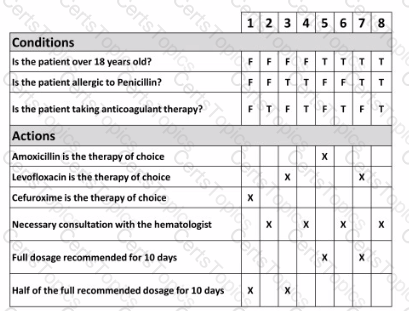
Based only on the given information, which of the following statements is TRUE?
Which of the following statements is true?
Which ONE of the following options MOST ACCURATELY describesstatement testing?
A typical objective of testing is to
For each of the test cases to be executed, the following table specifies the priority order and dependencies on other test cases
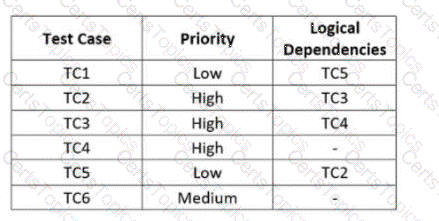
Which of the following test execution schedules is compatible with the logical dependencies and allows executing the test cases in priority order?
Which of the following statements best describes how configuration management supports testing?
Which of the following statements is not correct?
Which of the following issues cannot be identified by static analysis tools?
Match each objective to the correct test level
Objective:
A)Verifying whetherthe functionalandnon-functlonalbehaviorsof the system are as designed andspecified.
B)Verifying whetherthe functionalandnon-functlonalbehaviorsof the interfaces are as designed.
C)Verifying whetherthe functionalandnon-functionalbehaviorsof the components are as designedand specified.
D)Establishing confidence in the quality of the systemas a whole.
Test Level:
1.Component testing.
2.Integration testing.
3.System testing.
4.Acceptance testing.
Which ONE of the following options identifies the perspectives through which acollective authorship processgenerates a shared vision of user stories?
Use Scenario 1 “Happy Tomatoes” (from the previous question).
When running test caseTC_59, the actual result fort = 35degrees Celsius isOUTPUT = Xinstead of the expected output.
Which information should NOT be included in the defect report?
Which of the following characterizations applies to a test tool used for the analysis of a developer's code prior to its execution?
Which sequence of stated in the answer choices is correct in accordance with the following figure depicting the life-cycle of a defect?

Which ONE of the following options BEST describes a key characteristic of non-functional testing?
Which TWO of the following are benefits of continuous integration?
I. Allows earlier detection and easier root cause analysis of integration problems and conflicting changes.
II. Removes the need for manual test analysis, design and execution.
Hi. Removes the dependency on automated regression packs when integrating larger systems, or components.
iv. Gives the development team regular feedback on whether the code is working.
Select the correct answer:
Which of the following is a test-first approach, where tests that express a shared understanding from stakeholders of how the application is expected to work, are first written in business-readable language (following the Given/When/Then format), and then made executable to drive development?
Testing Quadrants, as a model, is effective in aligning stakeholders within Agile teams.
Which of the following examples demonstrates this?
The following diagram displays the logical dependencies between requirements and the individual requirement priorities. For example, "R2->R3" means that R3 is dependent on R2. Priority is indicated by the number next to the letter ”P" i.e. P1 has a higher priority than P2.
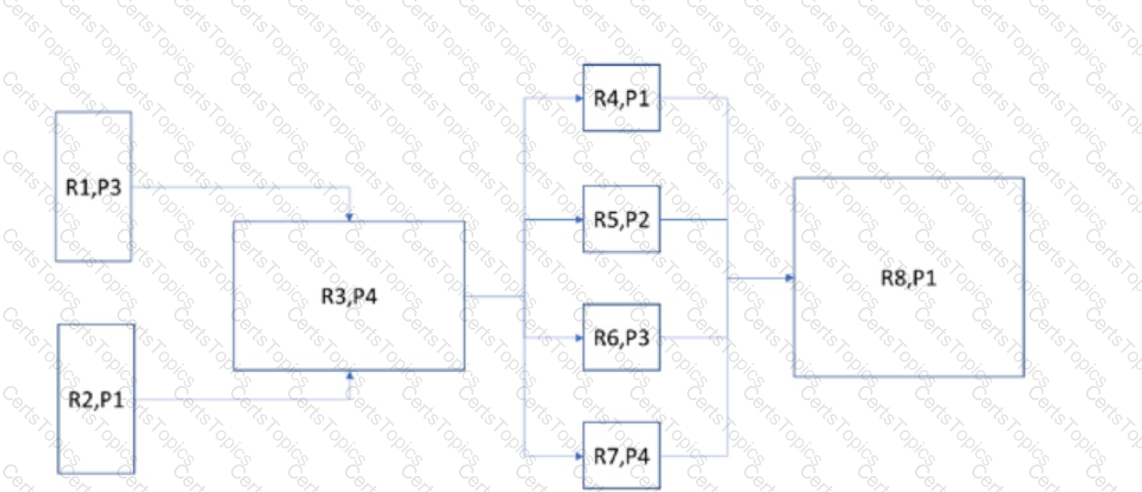
Which one of the following options best describes the test execution sequence using both requirement dependency and priority
The following rules determine the annual bonus to be paid to a salesman of a company based on the total annual amount of the sales made (referred to as TAS).
If the TAS is between 50k€ and 80k€, the bonus is 10%. If the TAS exceeds 80k€ by a value not greater than 40k€, the bonus is 15%. Finally, if the TAS
exceeds the maximum threshold which entitles to a 15% bonus, the bonus is 22%.
Consider applying equivalence partitioning to the TAS (Note: 1k€ = 1000 euros).
Which one of the following answers contain only test cases that belong to the same equivalence partition?
You are an experienced tester on a project with incomplete requirements and under pressure to deploy.
What type of testing should you do?
A requirement specifies that a certain identifier (ID) must be between 5 and 10 characters long, must contain only alphanumenc characters, and its first character must be a letter As a tester, you want to apply one-dimensional equivalence partitioning to test this ID. This means that you have to apply equivalence partitioning individually: to the length of the ID, the type of characters contained within the ID, and the type of the first character of the ID. What is the number of partitions to cover?
Which ONE of the following statements BEST applies tochecklist-based testing?
Consider the following table, which contains information about test cases from the test management system:
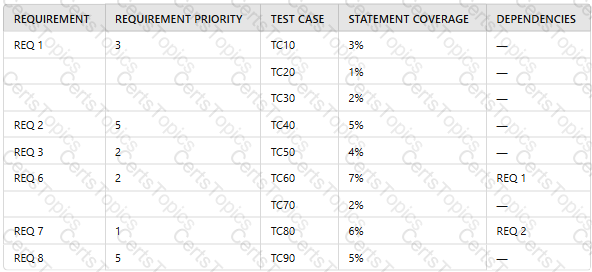
Which ONE of the following optionsorganizes the test cases based on the statement coverage strategy, while considering practical constraints?
Which ONE of the following options isNOTa benefit oftest automation?
Which review type, also known as a “buddy check”, is commonly used in Agile development?
The following 4 equivalence classes are given:
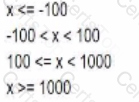
Which of the following alternatives includes correct test values for x. based on equivalence partitioning?
Determining the schedule for each testing activity and test milestones for a test project, using activity estimates, available resources, and other constraints is a typical task performed during